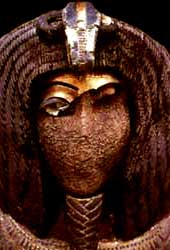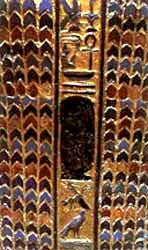|
|
|
|
1. Discovery of the Tomb Early in the digging season of 1907, Theodore M. Davis (an American Lawyer and infamous amateur Egyptologist) found a mysterious tomb just on the other side of the path from where, fifteen years later, Howard Carter (a previous employee of Davis) would find Tutankhamun's tomb. With Davis at this time were a number of friends and family - these included Joseph Lindon Smith (an American painter) also Corina his wife, Edward Ayrton (archaeologist) and Arthur Weigall who represented the antiquities service. Later they were joined by an artist - Harold Jones. 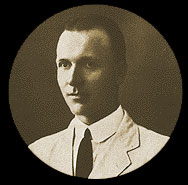 2. Excavating the Tomb  Finally after clearing the ancient debris left by the builders of nearby tombs, the diggers found a flight of twenty-one well-cut stone steps which lead down to a sealed entrance. This doorway was still closed by a "loosely-built wall of Limestone Fragments, resting not on the rock beneath, but on the loose rubbish which had filled the doorway". Blocking a doorway in this manner was unusual and should of been investigated more closely, unfortunately Davis's desire to find 'buried treasure' always made him conduct very poor excavations and so a lot of evidence has been lost due to his and his excavator's clumsy techniques. Behind the drystone wall was another obstruction, rough limestone blocks which were probably the original blocking material of the tomb. These limestone blocks had a hard cement-like coating which bore the impressions of an oval seal - the Jackal over nine tied captives (this was the same seal that was found on the walled-up doorway to Tutankhamun's own tomb). These seals were only found on the areas of the wall which had been repaired by necropolis officials when it had been found that thieves had entered the tomb. 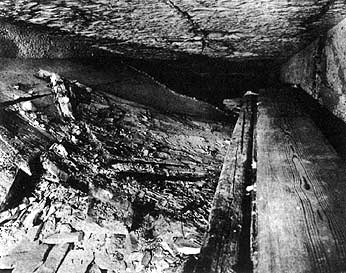 3. The Entrance Corridor  When the excavators had demolished the wall they found themselves in a corridor about 1.8 metres wide and 2.5 metres high which was filled with limestone chips to within a metre of the ceiling. However, lying on the filling near to the entrance was the side of a gilded wooden shrine and on top of that lay a door - part of the same shrine with copper pivots still in place. 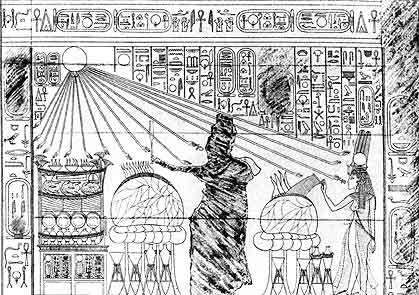 4. The Burial Chamber  The long sloping corridor led to a large rectangular room 7 metres long, 5 metres wide, 4 metres high and was sunk 1 metre below the level of the corridor. A slope of chippings led into the room and on this was a second part to the door of the shrine found in the corridor, also on this slope was a large alabaster vase stand. Various other parts of the shrine lay about the burial chamber - leaning against the opposite side of the chamber and also laying on the floor. All of the woodwork of the shrine was in a very fragile state and all that have survived are two planks that are now in the Cairo Museum. 5. The Canopic Niche 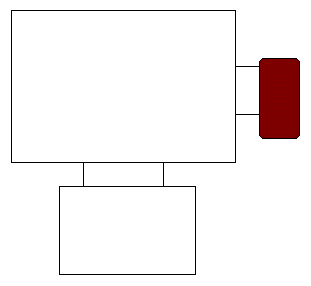 At the southern end of the burial chamber a new room had been started, but work had not gone very much further than forming a little alcove (1.8 metres high, 1.4 metres wide and about 1.5 metres deep). In this little 'niche' were found four canopic jars made from polished calcite with stoppers in the form of human heads wearing a short type of wig which was fashionable at the time with both men and women. Infact these heads have been identified with Kiya - a lesser wife of Akhenaten.  6. The Coffin 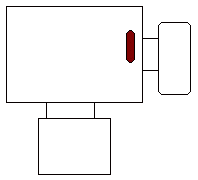 On the floor, lying just alongside the Canopic Niche was a coffin - at the time a coffin of this kind had never been found, but its style was later found to match the 2nd coffin in Tutankhamun's tomb (except the wig, the wig on the coffin in Tomb 55 matched the wigs on the set of canopic jars which was different from the standard royal funerary headress). The coffin had originally been placed on a lion-headed bier (again which matched one found in Tutankhamun's tomb), but here it had collapsed through decay and so the coffin had fallen to the ground, split open and had exposed the mummy. 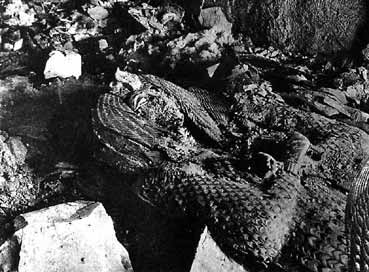
7. Contents of the Tomb Many small items were found amongst the rubble and chippings of the tomb: Four 'Magic Bricks' - in most tombs of this period these were placed at the four principal points in the walls of royal tombs. From the excavator's vague reports it is known that three were placed more or less correctly against appropiate walls except for one magic brick which was found underneath the bier. Faience vessels, boxes, amulets, the base of a wooden statue, statuettes, model boomerangs in faience and the remains of ritual implements used in burial ceremonies. One stone amulet bore the name of just Queen Tiye while several other items had the names of both Amenhotep III and Tiye. In the rubbish underneath the bier and also under the wooden panels which were leaning against the east wall were found numerous clay seal fragments some of which had the name of Tutankhamun impressed upon them. 8. Damage to the Tomb 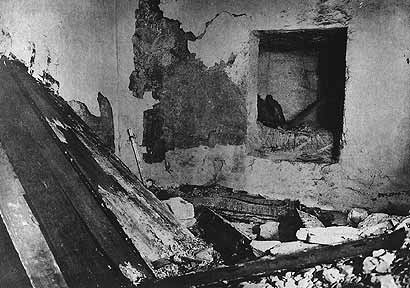 As soon as the excavators entered the tomb it was clear that it and the furniture inside had suffered a lot of damage not just from man in ancient times but also from more natural sources. A long crack had obviously appeared in the tomb not long after it was built - it showed signs of being plugged with a type of cement but to no avail - rainwater had seeped into the tomb and had done a significant amount of damage to the wooden items of the tomb as well as the mummy. The sign of deliberate damage was easy to see - the names on the coffin had been deliberately cut out and the face on the gold portrait mask ripped off and the lid removed. The uraei on the Canopic Jars had been snapped off and were missing, inscribed panels on the side of each jar had been chiselled away. Amulets on the Magic Bricks had been removed.
This 'selective vandalism' made it very clear that this was not the work of ordinary tomb robbers - there was gold which had been left behind and the tomb had been re-sealed. This tomb had obvioulsy been re-opened and then deliberately desecrated to remove all traces of the name and features of the original owner. |


